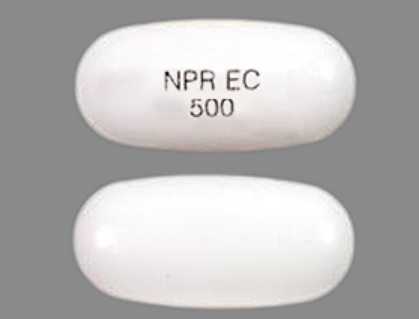EC-Naprosyn Interactions
There are 474 drugs known to interact with EC-Naprosyn (naproxen), along with 11 disease interactions, and 4 alcohol/food interactions. Of the total drug interactions, 101 are major, 346 are moderate, and 27 are minor.
- View all 474 medications that may interact with EC-Naprosyn
- View EC-Naprosyn alcohol/food interactions (4)
- View EC-Naprosyn disease interactions (11)
Most frequently checked interactions
View interaction reports for EC-Naprosyn (naproxen) and the medicines listed below.
- acetaminophen
- Acidophilus (lactobacillus acidophilus)
- Adderall (amphetamine / dextroamphetamine)
- amlodipine
- amoxicillin
- aspirin
- Ativan (lorazepam)
- biotin
- clonazepam
- Crestor (rosuvastatin)
- cyclobenzaprine
- Cymbalta (duloxetine)
- docusate
- duloxetine
- fluticasone nasal
- gabapentin
- ibuprofen
- Lexapro (escitalopram)
- methocarbamol
- omeprazole
- oxycodone
- pantoprazole
- Paracetamol (acetaminophen)
- prednisone
- tamsulosin
- Topamax (topiramate)
- tramadol
- Vitamin D3 (cholecalciferol)
- Zofran (ondansetron)
- Zyrtec (cetirizine)
EC-Naprosyn alcohol/food interactions
There are 4 alcohol/food interactions with EC-Naprosyn (naproxen).
EC-Naprosyn disease interactions
There are 11 disease interactions with EC-Naprosyn (naproxen) which include:
- asthma
- fluid retention
- GI toxicity
- rash
- renal toxicities
- thrombosis
- sodium
- anemia
- hepatotoxicity
- hyperkalemia
- platelet aggregation inhibition
More about EC-Naprosyn (naproxen)
- EC-Naprosyn consumer information
- Compare alternatives
- Pricing & coupons
- Drug images
- Latest FDA alerts (8)
- Side effects
- Dosage information
- During pregnancy
- Generic availability
- Drug class: Nonsteroidal anti-inflammatory drugs
- Breastfeeding
- En español
Related treatment guides
Drug Interaction Classification
| Highly clinically significant. Avoid combinations; the risk of the interaction outweighs the benefit. | |
| Moderately clinically significant. Usually avoid combinations; use it only under special circumstances. | |
| Minimally clinically significant. Minimize risk; assess risk and consider an alternative drug, take steps to circumvent the interaction risk and/or institute a monitoring plan. | |
| No interaction information available. |
See also:
Further information
Always consult your healthcare provider to ensure the information displayed on this page applies to your personal circumstances.


